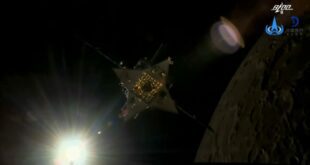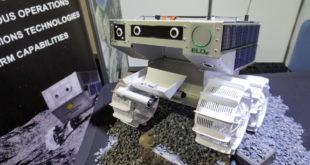 As 2018 comes to an end, we would like to take a moment and look back at some of the high – and low points of the last year. 2018 was a great year – no deadly accidents, more launches then ever and new space agencies around the globe. SpaceWatch.Global really enjoyed the diversity of the industry and its rapid growth. We started our journey three years ago with a strong focus on the wider Middle East, then we added Russia, Africa and Asia-Pacific, and last month we also added Europe to our SpaceWatch.Global coverage. Our spectrum ranges from space policy to deep space activities, from New Space companies to the geopolitical implications of space assets.
As 2018 comes to an end, we would like to take a moment and look back at some of the high – and low points of the last year. 2018 was a great year – no deadly accidents, more launches then ever and new space agencies around the globe. SpaceWatch.Global really enjoyed the diversity of the industry and its rapid growth. We started our journey three years ago with a strong focus on the wider Middle East, then we added Russia, Africa and Asia-Pacific, and last month we also added Europe to our SpaceWatch.Global coverage. Our spectrum ranges from space policy to deep space activities, from New Space companies to the geopolitical implications of space assets.
What did our Editors consider to be their highlights of 2018 for the global space industry and why?
Dr. John B. Sheldon, Chairman and Publisher
As a policy wonk and strategic analyst 2018 turned out to be an interesting, albeit controversial, year. Perhaps the most significant issue to emerge, and has yet to still play out, is the call by President Donald Trump to create a U.S. Space Force partly in reaction to what many U.S. officials since the Obama administration consider to be a growing threat to U.S. and allied satellites from Chinese and Russian counterspace capabilities. China and Russia, of course, have voiced their own concerns about the proposed U.S. Space Force and what that means for international security, but whatever your opinion on space security and who started what, 2018 was the year that hard geopolitics rose to prominence in space affairs for the first time since the end of the Cold War. 2019 promises more of the same, but hopefully not more so.
On a less ominous note, but certainly no less significant, 2018 also saw the continuing importance of space across the world with new space agencies being created and the elevation of space policy in national political discourses – Australia, Egypt, Ethiopia, the Philippines, Saudi Arabia, and Turkey come immediately to mind in this regard.
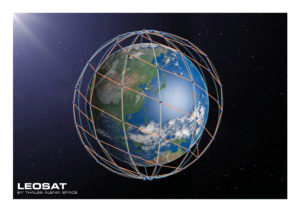
I know that this is supposed to be a review of 2018, but I’d like to use this opportunity to make a broad prediction regarding the boom in megaconstellation proposals: landing rights. The space debris risks, global capacity concerns, and so on have received ample coverage in 2018, but a significant risk to many of these business models requires more attention – the legal, policy, and regulatory ability of these companies to provide their satellite services in national markets around the world – has received scant attention and I predict that it will become more of an issue in 2019.
A highlight for me this past year has been persuading some of the brightest minds and interesting voices in the business to write for SpaceWatch.Global, offering our readers perspectives on the global space and satellite sectors that cannot be found anywhere else. I am also proud of our ongoing expansion to provide in-depth coverage of space and satellite activities and developments in Africa, Middle East, Asia-Pacific, Russia and the CIS, and more recently, Europe. This expansion reflects not only our commitment to providing coverage for under-reported regions, but also our conviction that the democratisation of space access, the rise of New Space and space commercialisation in general, and the inexorable continuation of geopolitics, are all combining to create interesting, and sometimes challenging, opportunities for entrepreneurs and policy makers alike.
I am always astounded by the sheer creative talent and tireless efforts of the SpaceWatch.Global team – Torsten, Helen, and our newbie, Maruska, – amaze me everyday and I am confident they will continue to do so in 2019.
Lastly, to our contributors, friends, families, and not least our subscribers and readers: thank you. Without your continued support, interest, feedback, and enthusiasm, none of this would be possible.
Torsten Kriening, COO and Editor
I had the great pleasure to moderate and speak at various very prestigious events this year. They included CabSat in Dubai (where I replaced Martin Jarrold from GVF); Global Space Congress in Abu Dhabi, a Ramadan Talk for AUDI in Dubai; and a moonshot talk at Future I/O congress in Venice. I was also blessed to interview the very top level people of the industry. They included Dr Mohammed AlAhbabi and Salem Al Marri, Daniel Porras, Marshall Smith, Dr Noah Raford, Dr Christina Giannopapa and Dr Michael Simpson. I would like to thank them for their time and the very valuable and open insights. Some topics that SpaceWatch.Global covered that really struck me included our Themed Week on Space Archaeology, the analysis on China’s One Belt One Road, the implications of Brexit on space, the rise of the Australian Space Agency and the development of Firefly.
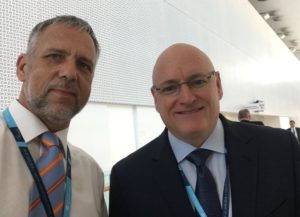
My personal highlights of the year were many, but the February Falcon Heavy launch by SpaceX and the synchronous landing of the two boosters on land stands out. In July, I also attended UNISPACE+50 held by UNOOSA in Vienna. At this event, I had the honour to meet astronaut Scott Kelly, and many other key people of the industry.
The Space Generation Congress held by the Space Generation Advisory Council was followed by the International Astronautical Congress in Bremen in September were my highlights. I was witness when Alex Gerst, ESA Astronaut with German nationality became the first German ISS commander on Germany’s National Day on 3 Oct. One of the most emotional interviews I carried out was with Mike Simpson on his last day as Executive President of the Secure World Foundation. This interview was read by more than 12.000 readers and made to our number one post within a week. In November, I had the pleasure to interview Dr. Scott Pace, the Executive Director of the National Space Council, during the 2nd annual Meeting of the Moon Village Association in Los Angeles. My highlight in December was the launch of Chinese Chang’e 4 Lunar mission to the far side of the Moon. With the current race of governments and private actors to the Moon, this is an important milestone
The FLOP of 2018 for me was the extension and then the end of the Google Lunar XPRIZE. After 10 years of inspiring teams around the world, this was a bitter end, especially as it was foreseen that not one of the participants could make it within the given framework. However, we will see moon landings in 2019 – I am very confident this will happen.
Helen Jameson, Editor-in-Chief
We’ve been talking about it for a long time and, for me, it’s amazing to think that humanity is actually about to take its first true foray into space tourism. We have seen the popularity of zero gravity flights become reality, which use parabolic manoeuvres to achieve weightlessness. However, in 2018, we came a very big step closer when Virgin Galactic became the first commercial company to successfully achieve its highest test flight to date, exceeding one altitude which is also known as the boundary of space. This is a huge achievement for Virgin Galactic and also space tourism overall. Safe to say, this is no longer a concept and the sheer acceleration in terms of the development of the vehicles that will get us to space is staggering. All of a sudden, it’s all beginning to happen. After the hiatus that humanity has experienced between the Moon landings, which seemed to promise so much,, we are on the very cusp of truly becoming space travellers. The private sector has had much to do with this acceleration in space travel development. With pioneering players pushing each other on to develop the transport that we need to get to space on a regular basis, and with the development of destinations in space, we are coming to a point where the ecosystem is in place to sustain space tourism into the future.
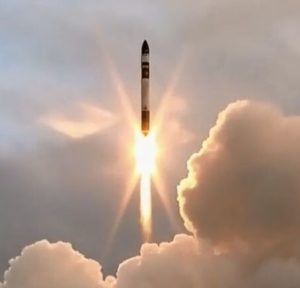
A second highlight of 2018 for me has to be speaking to Peter Beck, CEO of Rocket Lab. Apart from the groundbreaking Electron launch vehicle that he and his team has developed, I was also struck by his openness, honesty and the fact that he has such huge confidence in the fact that the Electron vehicle will touch so many people. I spoke to Peter in June, just before the ‘It’s Business Time’ mission window opened. Since then, the Electron has successfully deployed 24 small satellites into orbit and has begun high frequency launch operations. Not only that, but it has also secured a further $140 million in new funding. Electron is now providing the smallsat market with much-needed launch capacity at a time when small satellites are truly poised to be the future in space.
My third highlight was speaking to Ian Jones, CEO, Goonhilly. This is a man with a dream that has become reality. Goonhilly has always been a treasured icon of the UK space industry but when Jones took over he literally transformed the teleport. Years of hard work preparing the ground are finally paying off. The rapid growth and leadership of the UK in the smallsat industry sees iconic Goonhilly looking forward to a glittering future. With new financial backing and ambitions to extend its reach to deliver services on a global scale to the deep space and commercial satellite sectors, there is much to look forward to at the Cornwall-based teleport. It has become the world’s first private space teleport operator and now has opened a base in Australia, a country also seeing rapid space sector growth. With the renewed interest in exploring the Moon and Mars, space agencies have realised that the Moon is an ideal stepping stone onto other planets. With the 50th anniversary of the Apollo Moon landings coming up next year, there has been a great resurgence in interest not only by space agencies but by private companies. However many people have not given much thought about the ground infrastructure that’s going to be required, but that’s precisely what Goonhilly has been doing – they have spotted a gap in the market and are filling it. With plans for VTO and HTO spaceports in the UK and a flourishing space sector, Goonhilly is poised to take a leading role.
Finally, for me, as a Brit, Brexit has been a real cause for concern over the past year. Knowing the contribution that the UK has made to the Galileo programme, I was saddened to hear that UK businesses would be shut out of the development of the project into which the UK has already poured over £1.2 billion. Whilst this opens the door for the development of a new, sovereign system for the UK, which would be developed indigenously, this is a sad end to a great deal of hard work from UK companies. The UK space sector is strong, and let’s hope that, whatever the outcome, we can still cooperate closely with our space colleagues in the EU.
Maruška Strah, Editor
What a year 2018 was! I never expected it to turn out the way it did. As much as I was always in love with Outer Space and the International Law of Outer Space especially, I was on a completely different path when it comes to my work life. In February 2018, however, I decided to apply for an internship with UNOOSA and that decision had a much greater impact on my life than I ever anticipated.
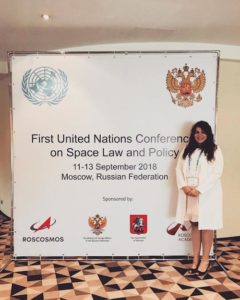 I’ve seen behind the scenes of UNISPACE+50 and had the privilege to be there during COPUOS and the working group on the Long term Sustainability of Outer Space. I will never forget how this event came to life, the discussions during the Committee sessions, the side events and all the amazing people I had the privilege to meet. We always hear how space must be used for peaceful purposes – for me, it was during UNISPACE+50 and COPUOS that I saw in real life, how much effort is put in truly maintaining space as peaceful as possible.
I’ve seen behind the scenes of UNISPACE+50 and had the privilege to be there during COPUOS and the working group on the Long term Sustainability of Outer Space. I will never forget how this event came to life, the discussions during the Committee sessions, the side events and all the amazing people I had the privilege to meet. We always hear how space must be used for peaceful purposes – for me, it was during UNISPACE+50 and COPUOS that I saw in real life, how much effort is put in truly maintaining space as peaceful as possible.
I concluded my internship in Moscow, at the First United Nations Conference on Space Law and Policy. This conference and being able to contribute to the organisation of it, was definitely one of the highlights of my time in UNOOSA. I had the pleasure to meet space law experts from all over the world and listening to their contributions, I learned so much about space law that I couldn’t learn from books. I was mesmerised by the City of Moscow and how grandiose Russia is. I can say without any doubt, that the highlight of this conference was the technical visit to the Yury Gagarin Cosmonaut Training Center. Seeing where cosmonauts actually train was truly an experience of a lifetime.
It was right after the the Conference that I received the news of being selected the new Executive Director of the World Space Week Association. World Space Week Association is the coordinator of the largest space related event on Earth, declared by the United Nations General Assembly to be held every year from 4 to 10 of October. I am especially excited about this opportunity, since it is the 20th anniversary since the UNGA Resolution declaring World Space Week!
I had the pleasure to participate in the IAC 2018 in Bremen and at the United Nations/Germany High Level Forum 2018 in Bonn. These two events were significant for me, because I had the honor to meet some of the key people of the industry, who made an impact on me personally and professionally.
Meeting incredible individuals, participating in space related events and being able to express my views on the use of Outer Space is what made my 2018 a year I will hold in a very dear memory. I grew as a person and as a professional, and I am looking forward to what the future will bring.
As we end another exciting and eventful year in the global space industry, we can look forward to more pioneering events, more incredible developments and to space being pushed up the agenda in countries across the world. We are entering a new space era and we at SpaceWatch.Global look forward to keeping you up-to-date as we continue on this incredible journey.
 SpaceWatch.Global An independent perspective on space
SpaceWatch.Global An independent perspective on space


